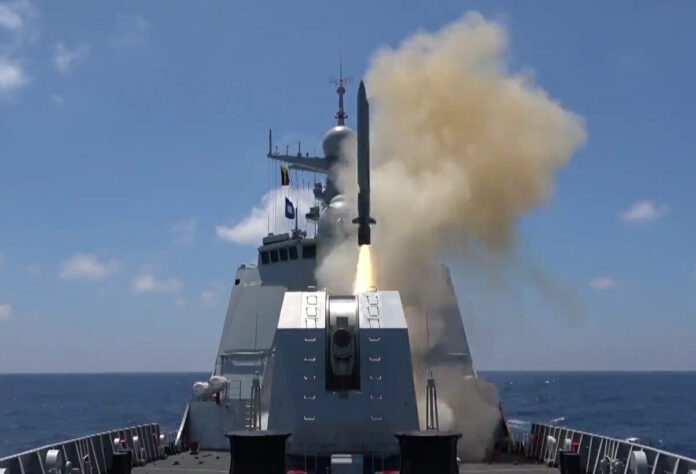People’s Liberation Army Navy’s surface warfare capabilities is getting more dangerous for the U.S. Navy with the YJ-18
Taiwan crisis occurred between the USA and China in 1996, proving that the Chinese naval power needed to be modernized since the U.S. Navy operated at very close distances to the mainland and showed off a significant threat to China during the crisis. So Chinese military investments have focused on acquiring the capability to threaten the U.S. Navy’s surface fleet and prevent it from operating in or near Chinese territorial waters in the event of a war. Anti-ship cruise missiles (ASCM) are the most important source of threat for the US Carrier Strike Group (CSG).
Since 1996, the People Liberation Army Navy (PLAN) has invested heavily in both its surface and submarine fleets, building or purchasing significant numbers of modern destroyers, frigates, and diesel or nuclear submarines abroad. In foreign purchases, the surface and submarine fleets obtained advanced ASCMs along with their launch platforms. For example, the PLAN acquired its first two Sovremenny-class destroyers from Russia in 2000. In 2005, it received eight modern Russian Kilo (Type 636) diesel submarines and two additional advanced Sovremenny-class destroyers. Both platforms came equipped with advanced, long-range, supersonic, Russian-made ASCMs: the surface-launched SS-N-22 Sunburn and the submarine-launched SS-N-27 Sizzler maximum ranges of 120 200 km, respectively.
China improved its ASCM strike capabilities
China has dramatically improved its ASCM strike capabilities through overseas acquisitions and indigenous development. ASCMs generally approach the target at low altitudes (5–10 meters above the surface) and either impact the target near the waterline or dive into it during terminal flight. Modern ASCMs receive offboard targeting data via data link, locate the target using GPS and multimode sensor packages, and strike maritime targets at long ranges (greater than 200 km). They can be launched by ground elements, aircraft, surface ships, and submarines.
The Type 055 cruiser, with a well-integrated sensor suite and 112 VLS cells, will markedly expand the PLAN’s range and firepower, which could substantially impact myriad potential conflict scenarios, from the Indian Ocean to the Korean Peninsula many in between. Because in addition to the Luyang III guided-missile destroyer and Renhai Carrier Group, Type 055 is equipped with the new vertically launched YJ-18 (based on Russian SSN-27), a long-range supersonic ASCM.

YJ-18 is a real thread for CSGs
China is currently fielding the H-6J bomber, a maritime derivative of the H-6K, which can carry up to six supersonic YJ-18 ASCMs each, allowing for saturation attacks against U.S. naval groups within the Second Island Chain. These will supplement the existing PLAN H-6G bombers capable of carrying up to four YJ-18 ASCMs. In addition, Chinese attack aircraft will launch the YJ-18 beyond the engagement range of the Navy’s Aegis Combat System and the SM-2 surface-to-air missiles that protect U.S. aircraft carrier strike groups.
The YJ-18 is a long-range torpedo tube-launched ASCM with a supersonic terminal sprint. This type of missile can fly at high subsonic speed upon launch but accelerate between Mach 2.5 and Mach 3 when approaching its target. This design keeps the missile light and far-reaching while also giving the enemy as little reaction time as possible. The weapon has been described as a dual-speed control ASCM since it enjoys certain advantages of subsonic missiles (more extended range, lighter design) and supersonic missiles (penetration capability). The YJ-18 carries a heavy explosive warhead, which, combined with the enormous kinetic energy from the fast speed, can severely damage a warship with tens of thousands of tons of displacement with only one strike. After the vertical launch, the missile’s turbojet engine can fly at a cruise speed of Mach 0.8 for about 180 kilometers.

After reaching that point, the warhead section separates, and a solid rocket engine ignites, allowing at a top speed of Mach 2.5-3 for about 40 kilometers. The missile can perform evasive maneuvers in the air before hitting by maneuvering at 10G acceleration to avoid enemy interception by air-to-air or surface-air missiles. The maximum range of 290 nautical miles has a light design and heavy explosive warhead that can severely damage a warship in just one stroke. The YJ-12 is almost impossible to intercept because its fast speed only leaves the enemy with a mere ten or so seconds to attempt an intercept. The YJ-18 will be important in allowing China to develop a genuinely expeditionary “blue water” navy.
Conclusion
In contrast to the situation in 1996, China can now hold the U.S. Navy’s surface fleet at risk at significant ranges from the mainland. Moreover, the extent of the threat to the U.S. surface fleet continues to grow. China’s anti-surface capability is founded on four developments: the establishment of an increasingly capable long-range surveillance system, which improves the PLA’s ability to detect and track surface ships at long ranges; the deployment of sophisticated anti-ship cruise missiles and the development of an ASBM with a range of 2,000 km; the acquisition of strike aircraft and surface ships with more excellent range and power; and the deployment of new classes of larger and quieter submarines armed with both torpedoes and cruise missiles.
The actual capabilities of China’s new ASCM are still unknown, but the revealed abilities prove that U.S. Navy carriers may not enjoy unquestioned dominance for much longer.
Check out Naval Library App to find out the specifications of YJ-18 anti-ship cruise missile.





